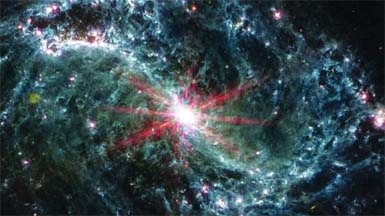Scientists in a new research have found evidence of nuclear fission occurring in the universe, particularly during the merging of neutron stars.
For years, astrophysicists have believed that heavy elements beyond iron are born in stellar explosions called supernovae or through the merging of neutron stars. However, recent research by scientists from Los Alamos National Laboratory and North Carolina State University proposes that fission might play a role in the u during the genesis of these heavy elements. Nuclear fusion and nuclear fission are two different types of nuclear reactions that release energy. In a fission reaction, the nucleus of an atom is bombarded with a neutron, which causes it to split into two or more smaller nuclei. This releases a large amount of energy, which can be harnessed for practical purposes. The technology is heavily used in nuclear reactors and even in atomic bombs. Scrutinising data from ancient stars, the researchers identified a potential fission signature, suggesting that nature may generate superheavy nuclei beyond the periodic table’s heaviest elements.
“People have thought fission was happening in the cosmos, but to date, no one has been able to prove it, Matthew Mumpower, a theoretical physicist at Los Alamos National Laboratory and co-author of the research paper published in Science, said in a statement.
Utilising the latest observations, Mumpower and the team identified a correlation between light precision metals like silver and rare earth nuclei such as europium. This positive correlation between the two groups of elements implies a consistent process during the formation of heavy elements, a phenomenon only explicable by fission.
“The only plausible way this can arise among different stars is if there is a consistent process operating during the formation of the heavy elements,” Mumpower said.
“As we’ve acquired more observations, the cosmos is saying hey, there’s a signature here, and it can only come from fission,” Mumpower added.
The findings not only confirm long-held theory but also suggest the existence of elements surpassing an atomic mass of 260, challenging existing models of heavy element formation and broadening our comprehension of the periodic table’s upper limits.
Source: HT
Scientists claim first hints of nuclear fission in universe
